As Eos first spread her yellow robe across the earth,
thunder-loving Zeus summoned an assembly of the gods
on the highest crest of many-ridged Olympus.
Homer Iliad
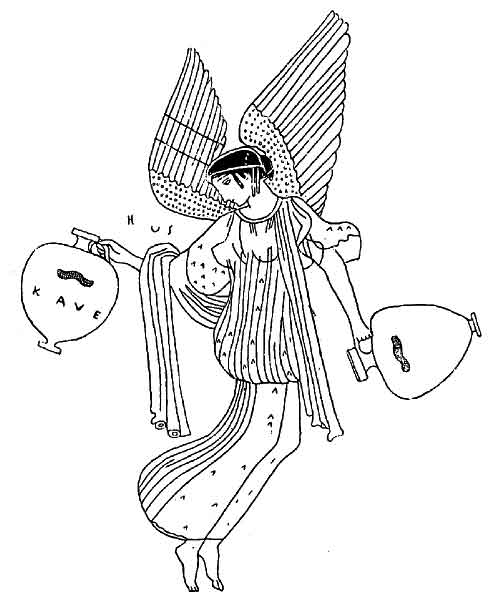
Eos from a vase painting
Eos ("dawn") was, in Greek mythology, the Titan Goddess of the dawn, who rose from her home at the edge of Oceanus, the Ocean that surrounds the world, to herald her brother Helios, the sun. As the dawn goddess, she opened the gates of heaven (with "rosy fingers") so that Helios could ride his chariot across the sky every day. In Homer (Iliad viii.1; xxiv.695), her yellow robe is embroidered or woven with flowers (Odyssey vi:48 etc); rosy-fingered and with golden arms, she is pictured on Attic vases as a supernaturally beautiful woman, crowned with a tiara or diadem and with the large white-feathered wings of a bird. Eos is the iconic original from which Christian angels were imagined, for no images were available from the Hebrew tradition, and the Persian angels were unknown in the West. The worship of the dawn as a goddess is inherited from Indo-European times; Eos is cognate to latin Aurora and to vedic Ushas.
Quintus Smyrnaeus pictured her exulting in her heart over the radiant horses (Lampos and Phaithon) that drew her chariot, amidst the bright-haired Horai, the feminine Hours, climbing the arc of heaven and scattering sparks of fire (1.48).
She is most often associated with her Homeric epithet "rosy-fingered" (rhododactylos), but Homer also calls her Eos Erigeneia:
"That brightest of stars appeared, Eosphoros, that most often heralds the light of early-rising Dawn (Eos Erigeneia)."
—Odyssey 13.93
And Hesiod: "And after these Erigeneia ["Early-born"] bore the star Eosphorus ("Dawn-bringer"), and the gleaming stars with which heaven is crowned."
—Theogony 378-382
Thus Eos, preceded by the Morning Star, is seen as the genetrix of all the stars.
Eos was the daughter of Hyperion and Theia (or Pallas and Styx) and sister of Helios the sun and Selene the moon, "who shine upon all that are on earth and upon the deathless Gods who live in the wide heaven" Hesiod told in Theogony (371-374). The generation of Titans preceded all the familiar deities of Olympus, who supplanted them.
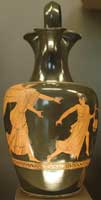
Eos hunting Tithonus, Louvre G438
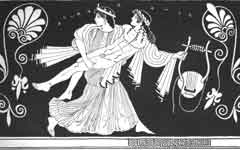
Eos with the captured Tithonus
Eos was free with her favors and had many consorts, both among the generation of Titans and among the handsomest mortals. With Aeolus, the keeper of the winds, she bore all the winds and stars. Her passion for the Titan Orion was unrequited. Eos kidnapped Cephalus, Clitus and Tithonus to be her lovers. Eos' most faithful consort was Tithonus, from whose couch the poets imagine her arising. She asked for Tithonus to be made immortal, but forgot to ask for eternal youth. Tithonus indeed lived forever but grew more and more ancient, eventually turning into a cricket.
Tithonus and Eos had two sons, Memnon and Emathion. Memnon fought among the Trojans in the Trojan War and was slain. Her image with the dead Memnon across her knees, like Thetis with the dead Achilles, are icons that inspired the Christian Pietà.
Eos kidnapped Cephalus when he was hunting. Some sources say he refused to be unfaithful to Procris, his wife; others that he had a relationship with Eos for some time and that she bore him three sons, but that he then began pining for Procris, causing a disgruntled Eos to return him to her - and put a curse on them. Cephalus accidentally killed Procris some time later after he mistook her for an animal while hunting; Procris, a jealous wife, was spying on him.
In the more restrictive Hellenic world, Apollodorus, a later Greek poet, claimed, in an anecdote rather than a myth, that her disgraceful abandon was a torment from Aphrodite, who found her on the couch with Ares. (Apollodorus, Library 1.27).
Her Roman equivalent was Aurora, her Etruscan equivalent was Thesan. The Dawn became associated in Roman cult with Matuta; later known as Mater Matuta she was also associated with the sea harbors and ports. She had a temple of the Forum Boarium. On June 11, the Matralia was celebrated at that temple in honor of Mater Matuta; this festival was only for women in their first marriage.

Cephalus and Aurora (Eos), by Nicolas Poussin, (c. 1630), 96,5 × 130,5 cm , National Gallery , London

Aurora and Cephalus, François Boucher
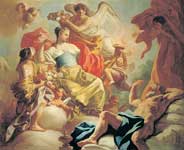
Aurora and Tithonus, Francesco de Mura
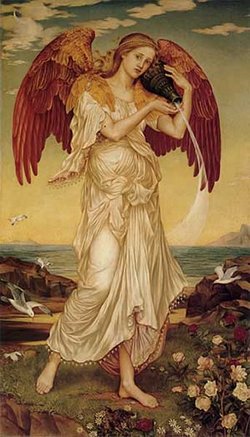
Eos, by Evelyn de Morgan (1850 - 1919), 1895 (Columbia Museum of Art, Columbia, SC): for a Pre-Raphaelite painter, Eos was still the classical pagan equivalent of an angel
Consorts/Children
Aeolus (Boreas, Eurus , Heosphorus, Notus, All the stars, Zephyrus)
Cephalus (Phaethon, Tithonos , Hesperos)
Images
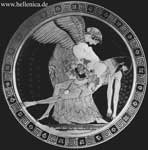
Eos and Memnon, Douris Painter, Louvre G 115
Aurora , Jean-Honoré Fragonard , 1755
Sculptures
Rodin - Eos and Tithonus (Washington, National Gallery of Art, 1905)
Tithonus once, the tale was, rose-armed Dawn,
love-smitten, carried off to the world’s end,
handsome and young then, yet in time grey age
o’ertook him, husband of immortal wife."
From the 4-th poem of Sappho discovered 2004
The name of the a Volkswagen Cabrio car is Eos. This name was selected in association with the feelings of driving a cabrio car in the morning of a summer day.
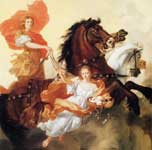
Asteroid 221 Eos
Links
- http://www.dartmouth.edu/~wareh/story.html (with a translation of the last discovered poem of Sappho)
- Eos (http://www.theoi.com/Ouranos/Eos.html): many references from Greek and Roman written sources, from Homer to Late Antiquity.
See also : Greek Mythology. Paintings, Drawings
Retrieved from "http://en.wikipedia.org/"
All text is available under the terms of the GNU Free Documentation License
| Ancient Greece
Science, Technology , Medicine , Warfare, , Biographies , Life , Cities/Places/Maps , Arts , Literature , Philosophy ,Olympics, Mythology , History , Images Medieval Greece / Byzantine Empire Science, Technology, Arts, , Warfare , Literature, Biographies, Icons, History Modern Greece Cities, Islands, Regions, Fauna/Flora ,Biographies , History , Warfare, Science/Technology, Literature, Music , Arts , Film/Actors , Sport , Fashion --- |

